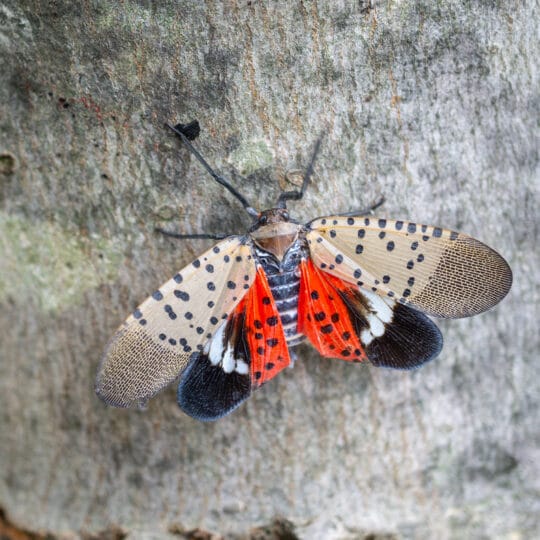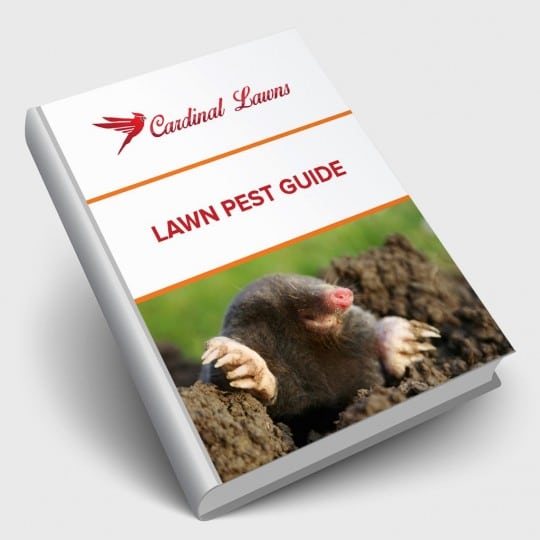Still Seeing Spotted Lanternflies?
How to Prevent and Treat Infestations
Posted
June 13, 2024

Are you still seeing large infestations of the spotted lanternfly? These pests have been soaring, hopping, and destroying crops for some time now. While sightings may have dwindled due to various treatment options, you may still see signs of this invasive pest. Learn more about spotted lanternfly treatment options to help protect your plants and the overall ecosystem.
Signs of the Spotted Lanternfly
Since you may notice this pest during various stages of its lifecycle, it’s best to familiarize yourself with the signs and habits of the spotted lanternfly.
- Eggs are laid in the fall and hatch in late spring. You may see mud-like masses on tree trunks, branches, and other smooth surfaces such as stones and outdoor furniture.
- Young lanternflies are black with white spots. Adults are about an inch long with greyish wings spotted with black, but when their wings open, they reveal a striking red underwing.
- Lanternflies feed on the sap of many plants, leaving behind a honeydew substances that promotes mold growth and weakens the plant.
- You may see swarms of lanternflies feeding on a particular plant. They prefer grapes and birch, walnut, and maple trees.
If you happen to have any of these plants in your yard or are concerned for your logging or orchard business, it’s best to prevent lanternflies and treat them at the earliest signs.
Preventing Lanternflies
If you’ve been infested with these pests before or you know you have the types of plants they prefer, be proactive about prevention.
- Regularly inspect your property for signs of pests and report sightings to local agricultural extension offices. These reports help to track infestations and eradicate the problem.
- Be aware that moving items harboring egg masses can spread lanternflies throughout the area. Be careful when moving firewood, furniture, and even your car.
- Work with leaders in your community to increase monitoring and control efforts and limit the threat of lanternflies, especially if you live in an area that relies on farming and logging.
If preventative measures don’t last, there are also several ways to treat a lanternfly infestation.
Spotted Lanternfly Treatment Options
While you can tackle a lanternfly infestation manually and chemically, using a combination of these methods may work best.
- In late fall or early spring, scrape any egg masses you find into a container of rubbing alcohol or hand sanitizer to kill the eggs.
- Use sticky bands around infested tree trunks to trap nymphs. Replace the bands regularly.
- You can make or purchase funnel traps to capture nymphs and adults without harming other garden insects.
- There are birds, spiders, and other predatory insects that feed on lanternflies. Allowing them to take up residence in your garden could be a natural way to rid your yard of these invasive pests.
- Apply a specially formulated insecticide to the soil or tree bark where the lanternflies are gathered. Once the tree absorbs the substance, it will kill the lanternflies as they feed on the sap.
- Some sprays are meant to be applied directly on nymphs and adults, however, these sprays can also impact beneficial insects.
While dealing with spotted lanternflies depends on watching for multiple signs of the pest and using a series of measures for prevention and treatment, there is an easier way. Contact the lawn care experts at Cardinal Lawns. With one call, you can get a professional consultation and effective plan for treating lanternflies and preventing their return.

Download Your FREE Lawn Pest Guide
Pests become most prevalent during the heat and humidity of summer. Take some time to learn about the signs of infestations before any damage can be caused to your landscape. This handy guide will teach you how to spot common lawn pests and how to keep them from causing harm to you and your property.